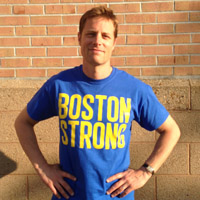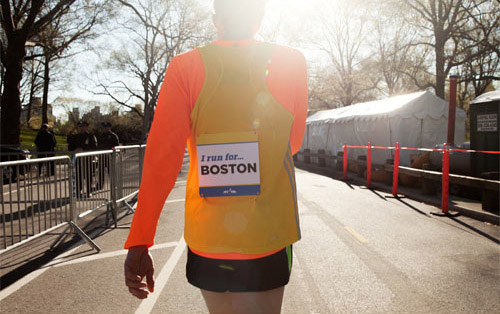 Longtime readers of this page know that one of the traditions of Boston Marathon weekend for Runner's World and Running Times staffers is to gather (sometimes more than once) at Bukowski Tavern for peanut butter and bacon burgers. So on Friday, April 12, while on a train to Boston, I sent around a meet-you-there email to 16 editors who would be in town to cover the race. A few hours later, a bunch of us were packed around a table in the back, licking grease from our fingers and ordering rounds of Sam Adams 26.2 Brew. That email chain circled back to me unexpectedly on Monday, race day, at 2:59 p.m. After covering the women's elite pack from the press truck, shooting some photos along the final stretch on Boylston near the grandstands, and working in the media center for a couple hours, I was at North Station, waiting to see what track my 3:15 train would depart from, when I checked my phone. One after another, emails with the subject line "PB&BB time" rolled in.
Longtime readers of this page know that one of the traditions of Boston Marathon weekend for Runner's World and Running Times staffers is to gather (sometimes more than once) at Bukowski Tavern for peanut butter and bacon burgers. So on Friday, April 12, while on a train to Boston, I sent around a meet-you-there email to 16 editors who would be in town to cover the race. A few hours later, a bunch of us were packed around a table in the back, licking grease from our fingers and ordering rounds of Sam Adams 26.2 Brew. That email chain circled back to me unexpectedly on Monday, race day, at 2:59 p.m. After covering the women's elite pack from the press truck, shooting some photos along the final stretch on Boylston near the grandstands, and working in the media center for a couple hours, I was at North Station, waiting to see what track my 3:15 train would depart from, when I checked my phone. One after another, emails with the subject line "PB&BB time" rolled in.
Warren and I r ok, let us know about u.
We're ok. Found my family and getting out of town ASAP. Be safe everyone.
What the hell? I scrolled down to see a separate chain started at 2:52 by members of our online team, subject line "Urgent."
Press center on lockdown. Nobody in or out.
Heard two loud noises. Spokesman referenced explosion at finish line.
I looked around the train station. The TVs were running replays of the Red Sox walkoff win at Fenway. No one looked panicked. I called my wife, who was up on the North Shore with our kids at my in-laws (in years past, they've all driven down so we could watch the end of the race together), and asked her to turn on the local news. She whispered, "Oh my God."
The story broke and began flying around the Web as I boarded the train. But real life hadn't caught up. I walked by a conductor and asked if the train would still depart. "Why wouldn't it?" he said.
I wasn't even supposed to be on this train. I was supposed to be on the 4:00. I was supposed to be sitting in the finish line grandstands, directly across from where the first bomb went off, watching friends and colleagues cross the line. I had just been there; I still had the grandstands pass in my jacket pocket. But for reasons I still can't fully explain, I decided to take an earlier train. I didn't look up from my phone the entire 45-minute ride. "Reply All" was how we began to account for one another when our world blew up on Boylston Street. Nothing has quite felt normal ever since. And I've learned that it's possible to be haunted by what didn't happen, obsessed by what might've been.
The July issue is dedicated almost entirely to what did happen in Boston, why it still matters, and what it will mean for all runners going forward. (We could not get any Boston coverage into our June issue, which had already been printed when the bombs went off.) But this issue -- and its tablet edition, enhanced on the iPad to include audio, video, and bonus articles not in the magazine -- covers the biggest story of the year, perhaps the most significant running-related story ever, with unprecedented depth, detail, emotion, and insight. It is the definitive record of that day from the runner's perspective.
It does not, however, dwell on only terror and tragedy. It also explores themes that have emerged in the weeks since: unity, resilience, hope, strength, community. Don Kern, a Michigan race director who was on Boylston during the bombings, wrote in an email, "If you're trying to defeat the human spirit, marathon runners are the wrong group to target." In keeping with that idea, we intended this issue to be cathartic and uplifting.
The centerpiece is a detailed oral history of the events of the day, told in the voices of 20 runners, spectators, first responders, medical personnel, and race officials. It begins at 6:15 a.m. on the seemingly perfect race day morning and concludes with reflections on the attacks and how runners are moving forward. To create this and the other stories in this issue, we conducted more than 50 interviews and commissioned more than two dozen photo and video shoots. Because they are passionate runners and RW readers, many interview subjects were willing to speak to us even though they didn't speak to other media outlets. We are truly grateful. We understand the runner-to-runner bond. Boston is an intensely personal story for us, too. There were more than a dozen Runner's World and Running Times staffers and freelancers near the finish line when the bombs went off. Four editors were running the race; Executive Editor Tish Hamilton was on Boylston and saw both explosions. After an agonizing several hours, we could say that everyone was safe and accounted for. Then the team shifted into reporting mode, posting news stories to our website throughout the following week.
The wall-to-wall media coverage was intense, and in this issue we set out to set the record straight on some of the misperceptions that became accepted postdisaster "truths," and to bring as many stories to completion as possible. You may have heard that groups of marathoners ran straight through the finish line to local hospitals to donate blood. Not quite true; some tried to but weren't allowed to give blood for risk of becoming dangerously dehydrated. You probably saw the photo of a spectator named Jeff Bauman, who'd lost his legs in the blasts but survived because a good samaritan in a cowboy hat rushed him in a wheelchair to an ambulance. In our coverage, you'll meet the guy in the cowboy hat, Carlos Arredondo, and read how Bauman's story played out.
To honor what happened in Boston on April 15, on our cover we shot an idealized, heroic-looking finisher's medal from this year's marathon -- but with a piece of black tape across its front. I wrote a blog about how we produced and chose this cover. It evokes a tradition among police officers and firefighters, who place a band of black fabric across their badges when one of their colleagues has died in the line of duty. It is mournful, but it is also a show of support and solidarity. We saw runners wearing finisher's medals this way around Boston after the race. This simple, powerful still life is a radical departure from a normal Runner's World cover -- appropriately so.
We also made some changes inside the issue in order to publish 60-plus pages of Boston coverage. Although our Training, Fuel, and Mind+Body sections appear as they always do -- expanded with a special marathon training package -- there is no Gear or Races+Places section this month. Next month, we will return to our regularly scheduled programming. Trust me, we're ready for anything that at least feels normal.
Coming out of traumatic events, people often say that it can help to immerse yourself in work. When we immersed ourselves in work, we went deeper into the trauma. But I'm immensely proud of this talented and resilient staff, and of the issue they created. Producing it has made us closer and reminded us that while running may feel inconsequential in the face of tragedy, it is essential as a way to heal.
More runners than ever already want to run Boston next year. We don't yet know what "Boston" will mean in 2014, although it seems impossible that a single marathon will be enough. But we -- like so many of you -- will be there, changed by what happened but unbowed.
David Willey, Editor-in-Chief
@DWilleyRW

Showing the love: A runner at a Boston tribute run in New York's Central Park on April 21 (photograph by Emiliano Granado).

Our special iPad edition is enhanced with audio, video and interactives about the runners, spectators and first responders in Boston. And our Boston Marathon page on runnersworld.com has articles, videos and slideshows from the race and the aftermath.
For more by David Willey, click here.
For more on fitness and exercise, click here.